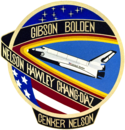Steven Hawley
| Steven Hawley | |
 | |
| NASA-astronaut | |
|---|---|
| Tillstånd | Ej aktiv |
| Född | 12 december 1951 |
| Tid i rymden | 32 dagar, 2 timmar, 42 minuter |
| Urvalsgrupp | Astronautgrupp 8 den 16 januari 1978 |
| Uppdrag | STS-41-D, STS-61-C, STS-31, STS-82, STS-93 |
| Uppdragsemblem | |
Steven Alan Hawley, född 12 december 1951 i Ottawa, Kansas, är en amerikansk astronaut uttagen i astronautgrupp 8 den 16 januari 1978.
Biografi
Hawley fick sin grundutbildning i Salina i Kansas och blev bachelor of arts i fysik och astronomi med högsta betyg vid University of Kansas år 1973. Han doktorerade i astronomi och astrofysik vid University of California år 1977.[1]
Hawley var forskningsassistent vid U.S. Naval Observatory i Washington, D.C. under sommarlovet 1972 och på Green Bank-observatoriet i West Virginia under somrarna 1973 och 1974. Innan han utsågs till astronaut arbetade han som forskare vid Cerro Tololos interamerikanska observatorium i Atacamaöknen i Chile.[1]
Han var gift med USA:s första kvinnliga astronaut Sally Ride[2] 1982–1987.
Rymdfärder
Källor
- ^ [a b] ”STEVEN A. HAWLEY (PH.D.) NASA ASTRONAUT (FORMER)”. NASA. 4 augusti 2024. https://www.nasa.gov/sites/default/files/atoms/files/hawley_steven.pdf. Läst 13 februari 2024.
- ^ ”Sally Ride, the first US woman in space, dies aged 61” (på engelska). https://www.bbc.com/news/world-us-canada-18963939. Läst 13 februari 2024.
Media som används på denna webbplats
STS-41D Mission Insignia
- The official mission insignia for the 41-D Space Shuttle flight features the Discovery - NASA's third orbital vehicle - as it makes its maiden voyage. The ghost ship represents the orbiter's namesakes which have figured prominently in the history of exploration. The Space Shuttle Discovery heads for new horizons to extend that proud tradition. Surnames for the crewmembers of NASA's eleventh Space Shuttle mission encircle the red, white, and blue scene.
STS-82 Mission Insignia
- STS-82 is the second mission to service the Hubble Space Telescope (HST). The central feature of the patch is HST as the crew members will see it through Discovery's overhead windows when the orbiter approaches for rendezvous, retrieval and a subsequent series of spacewalks to perform servicing tasks. The telescope is pointing toward deep space, observing the cosmos. The spiral galaxy symbolizes one of HST's important scientific missions, to accurately determine the cosmic distance scale. To the right of the telescope is a cross-like structure known as a gravitational lens, one of the numerous fundamental discoveries made using HST Imagery. The names of the STS-82 crew members are arranged around the perimeter of the patch with the extravehicular activity's (EVA) participating crew members placed in the upper semicircle and the orbiter crew in the lower one.
STS-61-c mission patch
- Columbia, which opened the era of the Space Transportation System with four orbital flight tests, is featured in re-entry in the emblem designed by the STS-61C crew representing the seven team members who manned the vehicle for its seventh STS mission. Gold lettering against black background honors the astronaut crewmembers on the delta pattern surrounding colorful re-entry shock waves, and the payload specialists are honored similarly below the sphere.
STS-31 shuttle mission flight insignia. The mission insignia for NASA's STS-31 mission features the Hubble Space Telescope (HST) in its observing configuration against a background of the universe it will study. The cosmos includes a stylistic depiction of galaxies in recognition of the contribution made by Sir Edwin Hubble to our understanding of the nature of galaxies and the expansion of the universe. The STS-31 crew points out that is it in honor of Hubble's work that this great observatory in space bears his name. The depicted Space Shuttle trails a spectrum symbolic of both the red shift observations that were so important to Hubble's work and new information which will be obtained with the HST. Encircling the art work, designed by the crew, are the names of its members.
NASA Astronaut Steven Hawley
Space shuttle mission patch





